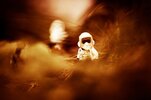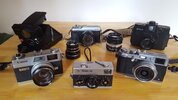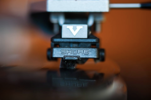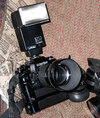The FM2n is a glorious piece. Closest I come in Nikon bodies is my old F2S, though I do have a FE. I've never actually handled a N80. I also have a F4S which really is an amazing camera. Big, heavy and yet incredibly delicate and precise to work with and still all of those lovely dials like a "real" camera.

Oh yeah, I also have a N2000, gift from a neighbour when they moved last Fall. It came with the "good" 50 f1.8 AIS so a nice little present.
What I like about using old glass on the full-frame Nikon bodies is that apart from having to dial up the lens I've mounted from a list I've set up in the menu (hooked into a single-button operation) I just use them exactly the same way as on the film bodies. I even get "Matrix", spot etc. metering with most of them. The only company to make the whole thing so seamless was Nikon with Pentax runner-up.

 Oh yeah, I also have a N2000, gift from a neighbour when they moved last Fall. It came with the "good" 50 f1.8 AIS so a nice little present.
Oh yeah, I also have a N2000, gift from a neighbour when they moved last Fall. It came with the "good" 50 f1.8 AIS so a nice little present. I once knew more about that fit want flange mount wise -- then once mirrorless took over I figured it would not matter much for long.... I am stuck with a Canon 5D mkII and 6D ff 35mm DSLR's. I found that these cameras also mount to 95% of all F mount Nikon glass, AI or Non-AI using $10 adapter rings. I then found out actually liked some native canon glass... so don't use the Nikon stuff to much these days. I shoot only manual, studio setting tethered to a Android tablet in Live View. The photos can then be FTP uploaded immediately. It's a rig, and it's sad that Sony and the others just don't let you tether much.
I once knew more about that fit want flange mount wise -- then once mirrorless took over I figured it would not matter much for long.... I am stuck with a Canon 5D mkII and 6D ff 35mm DSLR's. I found that these cameras also mount to 95% of all F mount Nikon glass, AI or Non-AI using $10 adapter rings. I then found out actually liked some native canon glass... so don't use the Nikon stuff to much these days. I shoot only manual, studio setting tethered to a Android tablet in Live View. The photos can then be FTP uploaded immediately. It's a rig, and it's sad that Sony and the others just don't let you tether much.


